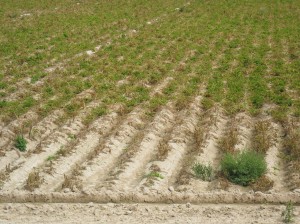19 August 2014 (01:53 UTC-07 Tango)/22 Shawwal 1435/28 Mordad 1393/24 Ren-Shen 4712
“…..just the beginning. The opportunity for this thing to be explosive in its spread is definitely there.”-Phil Nolte, University of Idaho
A few days ago it was reported by local news media that potato late blight was devastating crops in Bingham County, I can tell you it’s here in Bannock County, and it started back in July.
Don’t blame the drought, since the end of July eastern Idaho has been hit with abnormal rain, so much that University of Idaho pathologists warned the unseasonable heavy rain is causing late blight (Phytophthora infestans). Late blight was confirmed in Blackfoot farm fields on 11-12 August 2014, in Bingham County.
I can tell you that the farm field on the west side of Chubbuck (Bannock County) was showing signs of disease before the heavy rains started, back at the beginning of July. It’s an irrigated farm, and several types of crops are rotated every year. The farmer stopped irrigating by the time the rains hit.

Check out the devastation. Back in July the potato plants were more than 2 feet tall, now they’re dead! The only plants growing now are the tumble weeds! Late blight killed off the large fields in only a few weeks time.
Apparently it only takes the late blight fungus about five days to begin spreading spores (the spores travel by air).
A late blight is blamed for the infamous Irish Potato Famine, and it made its way to North America in the late 1800s. But ever since the 1990s new strains of late blight evolved in Mexico, and are making their way north. The new strains are considered more lethal than the old Irish Potato Famine version. It attacks tomatoes as well.
University of Idaho ag officials stated that spraying fungicides should kill the blight, however they admitted many farmers are short on cash and can’t afford the chemicals. A farmer from Aberdeen (Bingham County) stated that he hoped his anti-early blight spray would suffice for preventing late blight, due to cost concerns. After all, potatoes haven’t really been a money making crop for Idaho farmers (despite the propaganda spouted in the metropolitan areas of the United States).
It’s not just potatoes, Idaho hay/alfalfa growers are facing fungus problems due to the unseasonal heavy rains. By the end of the first week of August, Jefferson and Bingham counties reported record rain fall totals.
Hay farmers had already shipped off their first cuts, but University of Idaho officials reported that the second cut (now stacked in bales) is in jeopardy of mold contamination due to being soaked: “…..there was enough rain on uncovered stacks that it probably went through the first bale. We could have more hay fires and a bunch of ruined hay. Monitor your stacks.”-Glenn Shewmaker
A Blackfoot hay farmer reported that his hay stacks had already turned black with mold: “It’s the ugliest hay I’ve ever been a part of!”-Dewey Stander, lost 404 hectares (1-thousand acres) of cut hay
Up ’till now the U.S. Department of Agriculture (USDA) had been making optimistic reports regarding agricultural crop production in Idaho.
But there’s more climate change threats coming for Idaho farmers. Climatologist Cliff Harris says he and his colleges agree that Idaho could see a colder than normal Autumn (our temps have actually been unusually cool for August). He even warns that there could be hard freezes in September, meaning less food for you city folks to eat.
